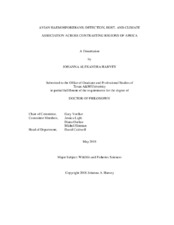Avian Haemosporidians: Detection, Host, and Climate Association Across Contrasting Regions of Africa
Abstract
Avian haemosporidians make up one of the most widely distributed and diverse vector borne parasite systems, found nearly worldwide. While there has been growth in the use of avian haemosporidians as a model system for vector borne parasites, there remain unanswered questions in this system. Little remains known of the variation in results when assessing various source materials and how these recoveries bias our results. Further, a majority of avian haemosporidian diversity likely remains undiscovered particularly across sub-Saharan Africa. Each new recovery helps to further elucidate distributional patterns of diversification.
Few studies have addressed the importance of source material selection when assessing these relationships. We show that source material, here blood and pectoral muscle, do not yield equivalent results when assessing prevalence and genetic diversity of haemosporidian genera. We find higher prevalence and genetic diversity is recovered from blood versus pectoral muscle for Haemoproteus. Contrastingly, we find that a higher prevalence of Plasmodium is detected from pectoral muscle, while higher genetic diversity is recovered from blood. Results indicate that source material may bias parasite detection and be an important factor in study design.
We conducted the first sampling of avian haemosporidians, Haemoproteus, Leucocytozoon, and Plasmodium from Benin located in tropical West Africa and the Democratic Republic of the Congo. We sampled 222 and 421 birds, respectively, across distinct ecoregions with varied habitats. We detected haemosporidians in 113 of 222 individuals, resulting in a 50.9% infection rate in Benin. We detected haemosporidians in 187 of 421 individuals, resulting in a 42.4% infection rate in the Democratic Republic of the Congo. We molecularly recovered a high number of novel lineages, 52.9% and 71.4%, respectively. We characterized the multivariate variables which influence the distributions of haemosporidians genetic lineages, including host associations and bioclimatic variables for sampling from Benin. We introduce a novel visualization method to better capture the multivariate environment of haemosporidians, and this approach resulted in the recovery of intra-generic distribution patterns of diversity. We assessed host life history traits as a proxy for vector encounter rate and examined the variation in expressed traits across families with high sampling.
Citation
Harvey, Johanna Alexandra (2018). Avian Haemosporidians: Detection, Host, and Climate Association Across Contrasting Regions of Africa. Doctoral dissertation, Texas A & M University. Available electronically from https : / /hdl .handle .net /1969 .1 /173332.


